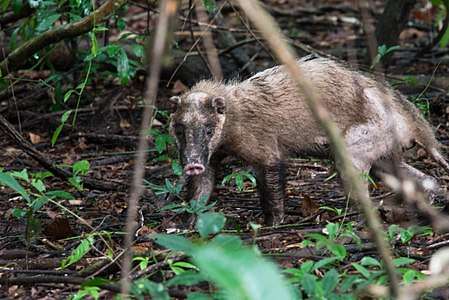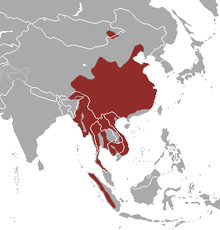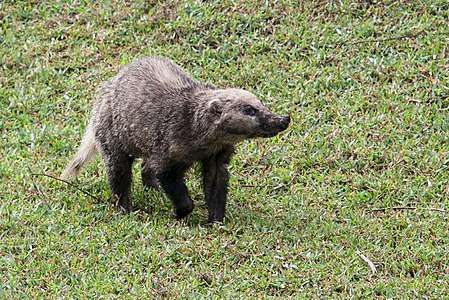Hog badger
The hog badger (Arctonyx collaris), also known as the greater hog badger, is a terrestrial mustelid native to Central and Southeast Asia. It is listed as Vulnerable in the IUCN Red List of Threatened Species because the global population is thought to be declining due to high levels of poaching.[1]
| Hog badger | |
|---|---|
 | |
| Hog badger in Huai Kha Khaeng Wildlife Sanctuary, Thailand | |
| Scientific classification | |
| Kingdom: | Animalia |
| Phylum: | Chordata |
| Class: | Mammalia |
| Order: | Carnivora |
| Family: | Mustelidae |
| Subfamily: | Melinae [2][3] |
| Genus: | Arctonyx Cuvier, 1825 |
| Species: | A. collaris |
| Binomial name | |
| Arctonyx collaris Cuvier, 1825 | |
 | |
| Hog badger range | |
Description
It has medium-length brown hair, stocky body, white throat, two black stripes on an elongated white face and a pink, pig-like snout. The head-and-body length is 55–70 cm (22–28 in), the tail measures 12–17 cm (4.7–6.7 in) and the body weight is 7–14 kg (15–31 lb).[4] With weights regularly reported from 8.4 to 12 kg (19 to 26 lb) it is one of the world's largest terrestrial extant mustelids going on average body mass, perhaps behind only the wolverine and rivaling the European badger (although it is not known to rival the weights of the latter, better-known badger during autumn hypophagia).[5][6]
Its appearance generally resembles the European badger, but it is generally smaller, with larger claws on the front feet. Its tail has long white hairs, and its front feet have white claws.
Distribution and habitat
The hog badger is considered fairly common in Thailand and in tropical evergreen forests and grasslands of the Terai in north-eastern India and eastern Bangladesh. It occurs in Indochina and in southern China.[1] Its distribution in Myanmar is considered patchy.[7] In the Indonesian island of Sumatra, hog badger occurs primarily above 2,000 m (6,600 ft) with one record at 700 m (2,300 ft).[8] There is one isolated record in eastern Mongolia.[9]
The following subspecies are recognized:[10]
- Greater hog badger A. c. collaris (Cuvier, 1825) – lives in the Eastern Himalayas;[11]
- Northern hog badger A. c. albogularis (Blyth, 1853) – occurs in southern China northwards to Shensi;[11]
- Chinese hog badger A. c. leucolaemus (Milne-Edwards, 1867) – occurs in northern China from southern Kansu to Chihli;[11]
- Sumatran hog badger A. c. hoevenii (Hubrecht, 1891) – lives in Sumatra;
- Indochinese hog badger A. c. dictator (Thomas, 1910) – lives in southern Thailand and Indochina;[11]
- Burmese hog badger A. c. consul (Pocock, 1940) – occurs from Assam to Myanmar.[11]
The IUCN considers the greater hog badger (A. collaris), the northern hog badger (A. albogularis) and the Sumatran hog badger (A. hoevenii) as three separate species. The greater hog badger is listed as a Vulnerable species.[1] The other two are listed as Least Concern.[12][13]
Gallery
Ecology and behavior
The hog badger is active by day and not very wary of humans.[14] Analysis of numerous camera trap pictures from Myanmar show no peak activity at either day or night.[15]
The hog badger is omnivorous; its diet consists of fruits, roots and small animals.
References
- Duckworth, J.W.; Timmins, R.J.; Chutipong, W.; Gray, T.N.E.; Long, B.; Helgen, K.; Rahman, H.; Choudhury, A. & Willcox, D.H.A. (2016). "Arctonyx collaris". IUCN Red List of Threatened Species. 2016: e.T70205537A45209459. Retrieved 30 October 2018.CS1 maint: multiple names: authors list (link)
- Koepfli KP, Deere KA, Slater GJ, Begg C, Begg K, Grassman L, Lucherini M, Veron G, Wayne RK (February 2008). "Multigene phylogeny of the Mustelidae: Resolving relationships, tempo and biogeographic history of a mammalian adaptive radiation". BMC Biology. 6: 10. doi:10.1186/1741-7007-6-10. PMC 2276185. PMID 18275614.
- Yu L, Peng D, Liu J, Luan P, Liang L, Lee H, Lee M, Ryder OA, Zhang Y (2011). "On the phylogeny of Mustelidae subfamilies: analysis of seventeen nuclear non-coding loci and mitochondrial complete genomes". BMC Evolutionary Biology. 11 (1): 92. doi:10.1186/1471-2148-11-92. PMC 3088541. PMID 21477367.
- Boitani, L. (1984). Simon & Schuster's Guide to Mammals. Touchstone. ISBN 978-0-671-42805-1
- Zhang, L., Zhou, Y. B., Newman, C., Kaneko, Y., Macdonald, D. W., Jiang, P. P., & Ding, P. (2009). Niche overlap and sett-site resource partitioning for two sympatric species of badger. Ethology Ecology & Evolution, 21(2), 89-100.
- Parker, C. (1979). Birth, care and development of Chinese hog badgers. International Zoo Yearbook, 19(1), 182-185.
- Than Zaw, Saw Htun, Saw Htoo Tha Po, Myint Maung, Lynam, A. J., Kyaw Thinn Latt and Duckworth, J. W. (2008). Status and distribution of small carnivores in Myanmar. Small Carnivore Conservation 38: 2–28.
- Holden, J. (2006). Small carnivores in central Sumatra. Small Carnivore Conservation 34/35: 35–38.
- Stubbe, M., Stubbe, A., Ebersbach, H., Samjaa, R. and Doržraa, O. (1998). Die Dachse (Melinae/Mustelidae) der Mongolei. Beiträge zur Jagd- und Wildforschung 23: 257–262.
- Wozencraft, W.C. (2005). "Order Carnivora". In Wilson, D.E.; Reeder, D.M (eds.). Mammal Species of the World: A Taxonomic and Geographic Reference (3rd ed.). Johns Hopkins University Press. pp. 532–628. ISBN 978-0-8018-8221-0. OCLC 62265494.
- Ellerman, J. R. and Morrison-Scott, T. C. S. (1966). Checklist of Palaearctic and Indian mammals 1758 to 1946. Second edition. British Museum of Natural History, London. Pages 274–275.
- Helgen, K.; Chan, B. (2016). "Arctonyx albogularis". IUCN Red List of Threatened Species. 2016: e.T70206273A70206436. doi:10.2305/IUCN.UK.2016-1.RLTS.T70206273A70206436.en. Retrieved 16 December 2019.
- Holden, J.; Helgen, K.; Shepherd, C.; McCarthy, J. (2016). "Arctonyx hoevenii". IUCN Red List of Threatened Species. 2016: e.T70205771A70205927. doi:10.2305/IUCN.UK.2016-1.RLTS.T70205771A70205927.en. Retrieved 16 December 2019.
- Duckworth, J. W., Salter, R. E. and Khounbline, K. (1999). Wildlife in Lao PDR: 1999 Status Report. IUCN, Vientiane, Laos.
- Than Zaw, Saw Htun, Saw Htoo Tha Po, Myint Maung, Lynam, A. J., Kyaw Thinn Latt and Duckworth, J. W. (2008). Status and distribution of small carnivores in Myanmar Archived 2015-04-28 at the Wayback Machine. Small Carnivore Conservation 38: 2–28.
External links
| Wikispecies has information related to Arctonyx |
| Wikimedia Commons has media related to Arctonyx collaris. |

